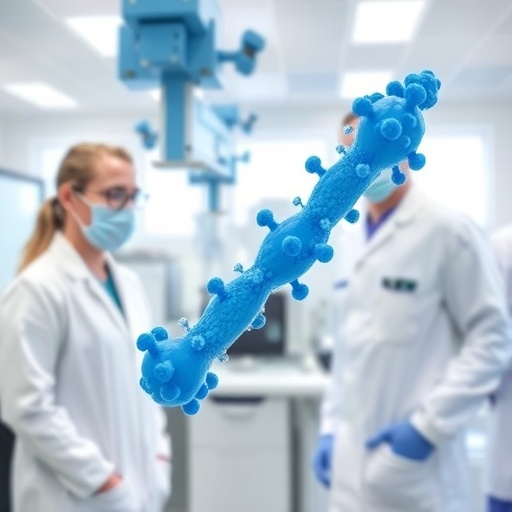Antibody-based therapeutics have revolutionized modern medicine, providing life-saving treatments for an array of diseases including cancer, autoimmune disorders, and chronic inflammatory conditions. However, despite their clinical success, these biologic drugs face a critical limitation in their formulation: when antibody solutions are concentrated to levels necessary for subcutaneous injection, they often become excessively viscous, complicating delivery and diminishing patient comfort. This viscosity challenge has long puzzled pharmaceutical scientists and limited the design of highly concentrated injectable antibody drugs. Now, groundbreaking research from Lund University offers a compelling mechanistic explanation for this phenomenon, potentially opening avenues for the development of new, easily injectable antibody formulations.
The viscosity of antibody solutions refers to their resistance to flow, which increases as these biologics become more concentrated. At high concentrations, antibodies tend to thicken the solution, making syringes difficult to use and injections painful. This physical behavior not only affects pharmaceutical manufacturing processes but also impacts patient adherence and quality of life. To better understand why viscosity spikes in such concentrated antibody solutions, researchers employed advanced computational simulations that delve into the molecular interactions driving this behavior.
Traditional models simplifying the structure and behavior of antibody molecules failed to capture the complexity of these solutions at high concentrations. The Lund research team, led by chemistry expert Fabrizio Camerin, discovered that the problem arises from transient, charge-driven clusters forming among the antibodies in solution. These clusters are not permanent aggregates but ephemeral structures stabilized by electrostatic interactions. The antibodies’ uneven and complex charge distributions foster these interactions, especially when combined with the surrounding ionic environment, which had been previously overlooked.
What emerged is a nuanced picture in which the electrical charges of the antibody molecules and the counterions in the solution work in tandem to create transient, dynamic networks. These networks momentarily connect antibodies, increasing the effective size and resistance to flow of the particles in the solution. This mechanism explains why simple models, which only accounted for static charge distributions or ignored surrounding ions, were inadequate. The research highlights how electrostatic forces not only shape structural arrangements in antibody solutions but directly modulate macroscopic properties such as viscosity.
This refined understanding enables the prediction of viscosity changes based on molecular properties and solution conditions. Pharmaceutical developers can harness these insights to rationally design antibody molecules with optimized charge patterns or modulate excipient composition to mitigate these electrostatically driven viscosity effects. For example, by strategically engineering surface charges on the antibody or adjusting salt concentrations in the formulation, it may be possible to prevent or reduce the formation of these thickening clusters.
The implications for drug delivery are significant. High-concentration antibody formulations that maintain low viscosity would dramatically ease administration by allowing smaller, less painful injections. This would not only improve patient comfort and compliance but also broaden access to life-saving antibody therapies by simplifying supply chains and enabling self-administration outside of clinical settings. Moreover, a better theoretical framework for antibody solution behavior could accelerate development timelines and reduce costly trial-and-error experimentation in formulation design.
Camerin emphasizes that this breakthrough stems from recognizing the integral role of electrostatics beyond static molecular descriptions. The interplay between charged antibody surfaces and their ionic milieu introduces complex dynamics that must be considered to capture the true physiochemical behavior of concentrated antibody solutions. Their simulations incorporate these electrostatic interactions with high fidelity, generating predictions that align closely with experimental rheology data, thus validating their approach.
This work also underscores the value of interdisciplinary collaboration, combining expertise in computational chemistry, biophysics, and pharmaceutical science. The integration of high-resolution simulations with empirical measurements paves the way for a new generation of formulation strategies grounded in fundamental molecular science. It highlights a broader trend in biologic drug development, where computational tools and theoretical frameworks increasingly drive innovation and optimization.
Future research will undoubtedly build on these findings by exploring how different classes of antibodies with varying shapes and charge distributions behave under concentrated conditions. It will also investigate how formulation additives and process parameters influence these electrostatic clusters. Such comprehensive mapping of formulation space promises a robust platform for predicting and controlling viscosity in monoclonal antibody therapeutics and beyond.
In conclusion, the novel insight that electrostatic interactions govern the temporary clustering and subsequent viscosity enhancement in concentrated antibody solutions represents a major advance in pharmaceutical science. This understanding equips developers with the knowledge to engineer more patient-friendly high-concentration antibody drugs, transforming treatment paradigms and enabling improved healthcare outcomes. As Fabrizio Camerin astutely notes, deciphering the mechanisms behind antibody viscosity is key to unlocking better treatment strategies and enhancing patient quality of life worldwide.
Subject of Research: Antibody-based drug formulations, electrostatic interactions, viscosity of concentrated protein solutions.
Article Title: Electrostatics and viscosity are strongly linked in concentrated antibody solutions
News Publication Date: Not specified
Web References: http://dx.doi.org/10.1073/pnas.2425974122
References: Published in Proceedings of the National Academy of Sciences
Keywords: antibody therapeutics, protein viscosity, electrostatics, computational simulations, formulation science, concentrated solutions, drug delivery, molecular interactions




